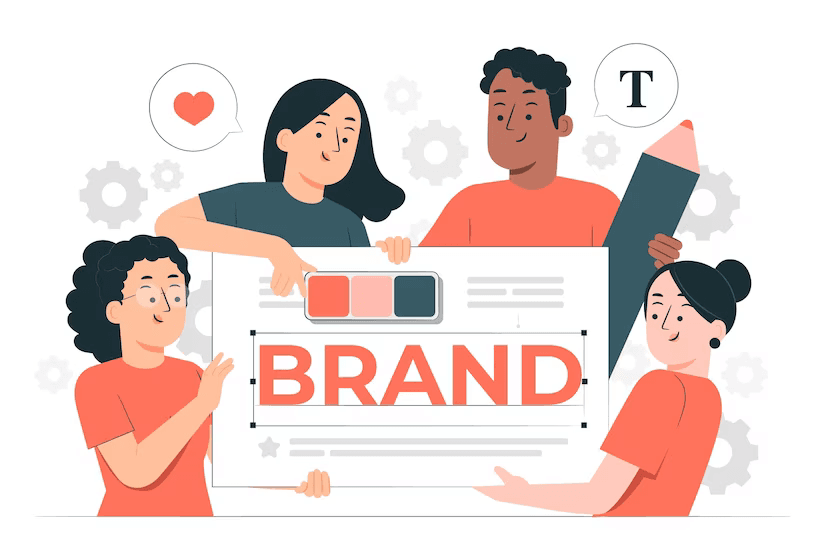Scroll down for more
Leveraging Your Company Values in Building Your Employer Brand

Introduction
What is an employer brand, and why do companies need to have a strong one?
An employer brand is a company's reputation as an employer that reflects how employees, job seekers, and the general public perceive it and comprises a company's values, culture, policies, and benefits to attract, retain, and motivate its employees.
An excellent employer brand has a direct impact on an organization's success, particularly in today's competitive labor market. Differentiating themselves from other employers through a strong employer brand can assist a firm in effectively attracting and retaining top talent, increasing employee engagement, enhancing the company's reputation, and eventually leading to greater profitability.
The benefits of a strong employer brand
A strong employer brand substantially aids this organization in recruiting and retaining top talent. In today's competitive employment market, most candidates prefer a positive work atmosphere, a talent-friendly corporate culture, and prospects for progress. Firms with a great employer brand may stand out and hire talent quickly and easily.
A strong employer brand also provides employees with exceptional values and a sense of pride in working for a great company, besides providing a pleasant work environment and exhibiting a dedication to employee well-being. Employees are more likely to stay with a company if they believe they are respected and supported.

Defining Your Employer Brand
The process of defining your employer's brand
A company's HR team can strengthen its employer brand by taking the following steps:
They must first assess their present employer's brand by gathering input from current and former employees, conducting surveys, and analyzing their online reputation. Consider what values distinguish the company and set it apart from competitors.
Second, they use the first stage to find distinctive value propositions. Values may include organizational culture, benefits, career growth opportunities, and work-life balance. Determine what attracts great talent and why they should choose your organization over others.
After you've identified unique value propositions, it's time to craft your brand message. It should be a clear and convincing statement providing offerings to employees. Ensure that all messages are consistent across all contexts, including a website, social media, job advertising, and internal communications.
Building and maintaining an employer brand is a lengthy process that requires significant analysis and continual effort. However, by following the methods above, the organization may attract and retain excellent employees while gradually building a reputation in the industry.

Examples of companies with strong employer brands and how they developed them Nowadays, multiple successful organizations with powerful employer brands send persuasive messaging about distinct values found only within theirs. We can list some names comprising:
Google has one of the world's most renowned and widely regarded employer brands with its innovative and engaging work culture, full employee perks, and obvious chances for career growth. Google's brand has grown because of a significant emphasis on the company's mission and principles.
Meta: It, formerly known as Facebook, is a worldwide technology firm with a strong employer brand. They concentrate on employee development, such as training programs, mentoring, or coaching, as well as health-related benefits like a retirement plan and parental leave.
Furthermore, emphasizing diversity and inclusion, such as fostering an environment for people of different backgrounds and perspectives to produce and take initiatives, is one of their goals.
The left part of their brand development strategy is to create a strong business culture that encourages employees to interact, communicate actively, and be transparent through internal events and external charity programs.
VNG: It is a Vietnamese technological business in which everyone wishes to work. VNG has a strong employer brand because of its emphasis on employee empowerment and innovation. It is particularly well-known for providing its employees with the autonomy and freedom to pursue their ideas and initiatives, resulting in a culture of invention and creativity.
Furthermore, they provide a wide range of comprehensive employee benefits, such as health insurance, flexible working hours, and possibilities for professional development, as well as many other perks, including on-site state-of-the-art facilities, fitness centers, and language training. Communicating Your Employer Brand The importance of communicating your employer brand and how to do so effectively As previously said, communicating your employer's brand is an essential component of developing your employer's brand. When employers effectively communicate their brands to the public, they may attract top talent looking for a workplace that resonates with their aims and beliefs.
A strong employer brand, on the other hand, will retain top talent by expressing chances for growth and development as well as the rewards and perks of working for your organization, which makes people proud and respected, leading to a long-term commitment to work.
Communicating your employer brand can aid in the building of a positive business culture by establishing clear standards and values and fostering a sense of responsibility and purpose. To do so effectively, the employer must give clear, succinct messages that are consistent across all platforms and align with your company's values, mission, and culture.
Use a variety of outlets, such as websites, social media, and job postings. Customize the message with the appropriate tone and language to capture the attention of the intended audience on each channel.
To demonstrate the company's culture and values, use employee testimonials and case studies. Potential applicants see what it's like to work at your organization and grasp the chances for growth and development as a result of this proof.
Measure the efficacy of your employer's brand communication efforts on a regular basis and make adjustments as needed. This ensures that the message has a favorable influence on the public and that the opportunity to acquire and retain top personnel is always high.
Highlight the various channels for communicating your brand.
Almost all firms currently embrace technology to attract talent, so when it comes to recruiting people, employers tend to invest in and take advantage of several channels involving:
Descriptions of jobs: When it comes to recruiting, the first step is to create job descriptions. Make sure to highlight the unique benefits of working for your organization in this task, along with a brief overview of your brand's culture, values, and expectations. To capture the attention of the candidates, use succinct language that is consistent with the tone and voice of your business.
Website: It is typically the second thing that potential customers and job seekers consider when looking for work. A reputable website correctly and successfully reflects the brand. The values of your brand can be communicated through concise and straightforward language, high-quality visuals, and interesting content.
Social media: The next useful channel is social media, such as Facebook, LinkedIn, Zalo, or Tiktok, which allow you to connect with customers and job seekers on a more personal level. Employers can share engaging and relevant material and interact with their followers, depending on the nature of each social platform.
Employee: It is a method of quickly hiring applicants through recommendations from friends and colleagues who have worked here and share the brand's values and culture with them.
Overall, make sure that all of your communication channels are consistent with your brand's values and objectives. You can establish a strong and identifiable brand that resonates with your target audience by creating a consistent and appealing message across all media.

Living Your Employer Brand
Aligning your actions with your employer's brand and how to do so effectively
Aligning behaviors with the employer brand is critical to developing a strong and consistent brand that connects with both current and prospective employees.
To expand the employer brand, the first thing employers must do is examine and identify what that brand is. It is now time to carefully analyze the values, mission, vision, culture, and unique selling point to be used in the branding process.
After listing these principles, employers should speak with their staff to define standards for behavior, communication, and decision-making.
Employ the proper people. Because the employer brand is heavily reliant on their employees, ensure that you hire people who are highly qualified and have common goals and beliefs.
Train your employees. It is critical to adequately train new employees on the company's principles and brand. They may acknowledge it and offer it to the public in the best way possible.
Evaluate the employer brand on a regular basis. To have an accurate review and make changes as needed, keep up with the trends across each channel and the development of the organization. After assessing, ensure that the employer has implemented branding strategies that align with its values and culture.
Various ways to live your brand
There are several approaches to keeping the brand alive and well in a competitive market:
Hiring procedure: The hiring procedure is an important opportunity to put the brand into action. Employer branding can be used to attract and recruit candidates who are a good fit for your firm and share your values and culture.
Onboarding: Although it is the final step in the hiring process, it has a significant impact on communicating the organization's culture and values to a new employee. During this time, an employer should provide a clear grasp of expectations and demonstrate how new workers may contribute to the organization's success.
Employee development: providing opportunities for employees to enhance their talents and progress within the organization that correspond with the employer brand
Recognize and reward: This point highlights the beneficial values of the organization for employees that align with the enterprise's objectives and values.
Employees that exemplify your brand's values and culture and their contributions to the firm's success should always be rewarded with incentives and possibilities for advancement.
Measuring the Success of Your Employer Brand
The importance of measuring the success of your employer brand and how to do so effectively
Measuring the success of the employer brand is a fundamental step in making the brand stand out in the market.
By measuring the entire employer brand process, the organization can evaluate the benefits and drawbacks of these methods as well as provide solutions to enhance or continue promoting them to align with the established values and perspectives.
To successfully and objectively measure the effectiveness of the employer brand, the employer should specify its goals and indicators, such as staff satisfaction and engagement, retention rates, and time to fill job vacancies.
The next stage is to collect and analyze data to measure your chosen metrics using surveys, interviews, and other methods of recruiting database systems.
The next stage is to use the findings of your analysis to strengthen your employer brand by refining your branding processes and making data-driven decisions. Track the progress of the new tactics in relation to the goals on a regular basis.
Key metrics for measuring brand success
The employer might choose various measures to gauge the success of the employer brand based on the aims and objectives of each organization. Here are a few examples:
Employee satisfaction: This indicator assesses how satisfied employees are with their jobs and the organization for which they work. Employers can gain a general overview of the results by conducting staff surveys.
Employee turnover is a metric that measures the number of layoffs and resignations. The higher the employee turnover rates, the lower employee satisfaction is, along with the negative impact of other issues on the brand's reputation.
Applicant quality: This indicator assesses the caliber of job candidates applying to work for an organization. A strong brand may attract great talent, but a poor brand may struggle to attract them.

Conclusion
In a nutshell, leveraging company values is a powerful way of cultivating the employer brand. The company's values should be at the core of everything the company does, from recruiting and onboarding to employee engagement and retention.
When they truthfully convey their values, they construct a culture that attracts top talent and nurtures employee loyalty and dedication.
Get our blog
Want the latest and greatest from our blog straight to your inbox? Chunk us your details and get a sweet weekly email.
Read more in our blog

Project Management
The Impact of Dynamic Pricing on Customer BehaviorExplore the impact of dynamic pricing on customer behavior and learn how to implement effective pricing strategies.

Project Management
Focus in Scrum: Keeping Your Team on TrackDiscover effective strategies to maintain focus within your Scrum team, overcome common challenges, and boost productivity.

Project Management
Key Metrics for Mobile App SuccessDiscover the essential metrics for mobile app success, from user acquisition and engagement to monetization and performance.
MLTECH SOFT